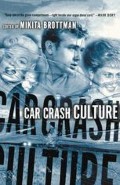Abstract
science fiction cinema has consistently, if unconsciously, manifested an intriguing split in its attitude toward the machine, treating it unabashedly as a dehumanizing oppressor while lovingly lingering over its gleaming gizmos. Crash, scripted nearly faithfully by David Cronenberg from English sci-fi writer J. G. Ballard’s 1973 cult novel, knowingly interrogates this ambivalence in a harrowing exploration of the human/machine symbiosis—specifically the human automotive interface. (Note that the director himself has been an amateur racer and car enthusiast.)
Access this chapter
Tax calculation will be finalised at checkout
Purchases are for personal use only
Preview
Unable to display preview. Download preview PDF.
Notes
See J. G. Ballard, Crash (New York: Farrar, Straus, and Giroux, 1994). Cronenberg/Ballard’s fusion of the human and the inanimate/mechanical has numerous precedents in early twentieth-century painting and theater that address a wide spectrum of ideological positions. The unabashed machine idolatry of many Futurists and Vorticists was informed by a prefascist sensibility. Russian Constructivism often valorized the human/machine interface in the name of the proletarian revolution. The leftist-inflected theatrical projects of Meyerhold in Russia, of Ernst Toller and Georg Kaiser in Germany inter alia prominently featured “biomechanical” tropes in script, acting, and set design.
For an extensive discussion, see Oscar G. Brockett, The History of Theater (Boston: Allyn and Bacon, 1974).
The seminal reference in this regard is Klaus Theweleit’s studies of the Freikorps, a loosely knit fellowship of disaffiliated young men, many former soldiers, who gathered together after World War I to redeem the Fatherland’s savaged honor in the context of what they perceived as the debasements of the Weimar Republic and the rising tide of Bolshevism. Klaus Theweleit, Male Fantasies: Volume 1: Women, Floods, Bodies, History, trans. Erica Carter, Chris Turner, and Steven Conway (Minneapolis: University of Minnesota Press, 1987); Male Fantasies: Volume 2: Male Bodies: Psychoanalyzing the White Terror, trans. Steven Conway, Erica Carter and Chris Turner (Minneapolis: University of Minnesota Press, 1989). Theweleit uses Freikorps mores and costumes as a springboard for a masterful analysis of masculine anxiety regarding castration and impotence, attendant terror of the feminine, and compensatory homosocial/homoerotic visions of male purity. This work has obvious, ominous currency regarding the contemporary American militia movement as well as other renascent fascist movements abroad.
Recent studies extending Thewelheit’s interrogations of the “armored body” include Scott Bukatman’s Terminal Identity: The Virtual Subject in Postmodern Science Fiction (Durham, NC: Duke University Press, 1993) and
Christopher Sharrett’s “The Horror Film in Neoconservative Culture,” in Barry Keith Grant, ed., The Dread of Difference: Gender and the Horror Film (Austin: University of Texas Press, 1996).
Editor information
Copyright information
© 2001 Mikita Brottman
About this chapter
Cite this chapter
Greenberg, H.R. (2001). Machine Dreams. In: Brottman, M. (eds) Car Crash Culture. Palgrave Macmillan, New York. https://doi.org/10.1007/978-1-137-09321-9_17
Download citation
DOI: https://doi.org/10.1007/978-1-137-09321-9_17
Publisher Name: Palgrave Macmillan, New York
Print ISBN: 978-0-312-24038-7
Online ISBN: 978-1-137-09321-9
eBook Packages: Palgrave Literature & Performing Arts CollectionLiterature, Cultural and Media Studies (R0)

